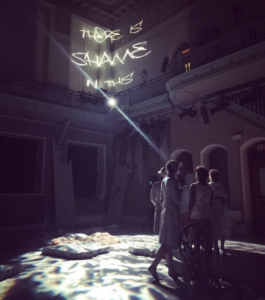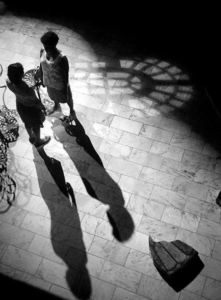
Review by James Wilkinson
Dark Room – Written by George Brant. Directed by Olivia D’Ambriosio. Associate Director/Dramaturg: Aleander Platt. Scenic Design: Ryan Bates. Costume Design: Chelsea Kerl. Lighting Design: Stephen Petrilli. Sound Design/Composer: Elizabeth Cahill. Properties: Esme Allen. Presented by Bridge Repertory Theatre at the Multicultural Arts Center at 41 Second St, Cambridge through August 16th
While speaking with an audience member after having seen Bridge Repertory Theater’s production of Dark Room, she remarked to me that she found it an interesting piece. “There’s a little something for everyone,” she said. I think she hit the nail on the head. The experience of sitting through Dark Room is most akin to being thrown through a kaleidoscope of shadowy landscapes. By turns sad, funny, disturbing and bizarre, the ground is constantly shifting below your feet. Just as you adjust, we’re off somewhere else. There’s an energy around the piece as though we’re watching it trying to figure out a problem in real time. Try this. Now try this. Here, try this. That didn’t work? Then try this. No? Then how about this? Together we inch along, searching for the answer to a mystery.
What exactly is Dark Room? Well, that’s kind of hard to pin down, especially since the piece is drawing from so many different genres and can be read in so many different ways. It’s a dance piece. It’s a dark comedy. It’s an absurdist sketch. It’s an affecting drama. It’s a sculpture come to life. According to the program, the spark of inspiration for the play is the life and work of Francesca Woodman, a New York-based photographer who tragically took her own life in 1981 at the age of twenty-two. Using the images that Woodman created as a jumping off point, playwright George Brant spins a series of vignettes that director Olivia D’Ambrosio connects with the help of twenty-two different actresses. A woman recounts the death of her young child. Two muses meet on the beach, waiting to stir up some inspiration. Three corpses lie in their caskets, pining for the loved ones they left behind. There is no larger narrative for the audience to follow. Characters in one scene don’t appear or get referred to in others. Each passes, connected only by an echo of theme and the lingering presence of Joni Mitchell’s Blue album.

The two great strengths of this production are the visual direction provided by Olivia D’Ambrosio and the extraordinary collection of actresses that she has assembled. D’Ambrosio created the piece with the cast over a series of development workshops and the care put into the visuals of the piece really shows. As the play progresses from scene to scene like movements within a concerto, there are some stunning stage images to take in. D’Ambrosio treats designer Ryan Bates’ set as a giant puzzle box, capable of hiding actresses until she needs them to pop out and take our attention.
The night that I attended the production, the house manager made an impassioned plea to the audience as a part of his pre-show announcements. He encouraged the audience to not worry about “getting it” while watching the performance. To not get caught up in having everything make sense and to look to experience play as you might experience a dream. I have to say that based on that introduction, I was expecting the play to be a lot more abstract than it turned out to be. Audience members who may be wary of abstractions, shouldn’t be afraid to attend Dark Room. Yes, the stories can turn a bit surreal at times, but there’s very little that couldn’t immediately be comprehended.
In fact, I would argue that the production provides a number of signposts guiding the audience towards possible interpretations of what they’re watching. D’Ambriosio’s staging opens with a woman at a second story window, gazing out at the ground below. In one long fluid movement we watch this woman rewind, moving backwards down to the first floor and across the stage. The implication (at least as I took it) is that we’re setting up an investigation of how we got here. By the end of the play, we will watch this woman retrace her steps, climb back up the stairs, go to the window and leap to her death (this isn’t exactly a spoiler since the program highlights that Woodman committed suicide). Why has she done this? Are there clues to be found in the work she left behind and the stories they highlight? The play seems to hint that it’s possible. One vignette features a character literally piecing together a large puzzle. If we could only find the right pieces, it may be able to give us a sense of the whole.
What unfortunately didn’t work for me was the dialogue within the script, which I think is the production’s weak spot. I don’t think it comes close to matching the visuals that the production creates. Characters slip into speaking in overly poetic and clichéd terms that feel shoehorned in rather than genuinely coming from who the characters are. It creates a layer of artificiality that has the nasty habit of deflating the genuine emotional moments that the actors are reaching for.
It’s oddly fitting that the inspiration for Dark Room was the work of a photographer, because my main take away from the production as I left the theater was a series of moments (or snapshots, if you will). At unexpected points through the play, the production will suddenly and briefly pop. An actress will find just the right way to deliver a line or commit to a movement that makes you sit up and take notice. That’s what I mean when I say that it feels the production is working out a problem in real time. It’s always reaching for these moments, trying to make that spark happen. It may not happen all the time, but when it does, it’s thrilling. For tickets and more information, visit their website: www.bridgerep.org

